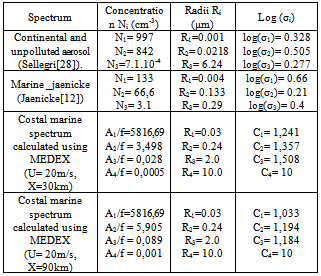-
Paper Information
- Next Paper
- Paper Submission
-
Journal Information
- About This Journal
- Editorial Board
- Current Issue
- Archive
- Author Guidelines
- Contact Us
Geosciences
p-ISSN: 2163-1697 e-ISSN: 2163-1719
2013; 3(2): 35-47
doi:10.5923/j.geo.20130302.01
Study of the Impact of the Natural Production of Coastal Marine Aerosols on the Dynamics and Microphysical Behavior of a Convective Cloud
Rabia Merrouchi1, Mohamed Chagdali2, Soumia Mordane2, Jacques Piazzola3
1National Meteorological Service of Morocco, BP 8106 Oisis. Casablanca, 20000, Morocco
2Faculty of sciences Ben M’sick, Casablanca, 20000, Morocco
3Laboratory of Electromagnetic sounding of Terrestrial Environment-(LSEET-LEPI), University of Toulon-Var, France
Correspondence to: Rabia Merrouchi, National Meteorological Service of Morocco, BP 8106 Oisis. Casablanca, 20000, Morocco.
| Email: |  |
Copyright © 2012 Scientific & Academic Publishing. All Rights Reserved.
The atmosphere contains suspended particles of various origins natural or anthropogenic that constitutes the atmospheric aerosol. The aerosol cloud interaction is a fundamental mechanism that influences the precipitation process. To study the impact of marine aerosols, especially those generated in coastal areas, on the dynamics and microphysical behavior of the clouds, two numerical models were coupled. The first, calculates the coastal marine aerosol spectrum that could be generated under a given weather condition at the sea surface. The predicted spectrum is then introduced, as initial aerosol spectra, to a cloud model with a detailed microphysics. The simulations performed have focused on a convective cloud (mixed phase) using distinct initial aerosols spectra of different origins in order to highlight the potential effect of marine aerosol naturally produced in surf zone on the dynamics and microphysics of the cloud. The results carried out indicates an important contribution of marine aerosol in the process of precipitation formation by promoting an early start of precipitation at lower altitudes, leading to increased amounts of precipitation reaching the ground.
Keywords: Interaction Aerosols-Cloud, Coastal Marine Aerosols, Cloud Microphysics
Cite this paper: Rabia Merrouchi, Mohamed Chagdali, Soumia Mordane, Jacques Piazzola, Study of the Impact of the Natural Production of Coastal Marine Aerosols on the Dynamics and Microphysical Behavior of a Convective Cloud, Geosciences, Vol. 3 No. 2, 2013, pp. 35-47. doi: 10.5923/j.geo.20130302.01.
Article Outline
1. Introduction
- The aerosol-cloud interactions represent a fundamental mechanism influencing rain process. Through the washout processes, the precipitation plays an important role in the elimination of atmospheric pollutants whether they are in the gaseous, liquid or solid state. On the other hand, clouds are also responsible for the vertical redistribution of gas and particles all along atmosphere as well as for their transport. When clouds form, they contain millions of water droplets in each cubic meter of air. Each of the cloud droplets is formed through condensation of the water vapor on the aerosol particles. The cloud model ExMix (External Mixture) has been developed to study mixed-phase clouds by integrating a detailed microphysics of the whole process of formation, growth and precipitation ([1],[2],[4]). EXMIX is dedicated to the different mechanisms behind the cloud formation and decay. The microphysics processes governing the growth of the water droplets inside the cloud depend on both the initial size spectrum and the chemical composition of aerosols caught in the updrafts feeding the cloud. The model EXMIX takes into account the initial thermodynamic profile and the aerosol spectrum in terms of distribution and chemical composition (solubility). This cloud model is based on a concept to follow every step of the evolution of aerosol particles (wetting, formation and growth of droplets and ice crystals).The number, the size distribution and the composition of atmospheric aerosols vary in time and space in response to their origin, arising from a variety of production sources and meteorological conditions. The aerosol sources can be of natural or anthropogenic origin. The coastal area represents a specific zone for cloud formation since convective processes which take place over land can be transported towards the ocean. In this case, aerosols caught in updrafts may have a mixed origin: sea spray aerosols punctually generated at the sea surface are added to a continental contribution issued from natural and/or anthropogenic sources[5]. With the soil dust, sea salt aerosol is the largest single source of aerosol mass injected into the atmosphere. For example, recent estimates suggest sea spray to be in the range of 103 to 104 Tg.yr-1 dry mass[6]. The aerosol mixture in coastal zones is strongly related to the changes in the wind direction that could be in turn accompanied by variations in meteorological parameters. While statistical, observational and numerical studies demonstrate a significant effect of marine aerosol particles on precipitation amount and spatial distribution (see [7-11]), special interest is given, in this paper, to the effect of aerosols produced in coastal area on the formation of convective clouds and precipitation processes. To this end, three distinct aerosol formulations were introduced, as initial aerosol spectrum, to the cloud model EXMIX. The first aerosol model is for particles of and unpolluted continental origin based on the work of Sellegri et al.[28]. The second one is for marine aerosol spectra developed by Jaenicke et al.[12] and the last one concern the Mediterranean coastal aerosol model MEDEX[13] which is dedicated to coastal conditions. To highlight the importance of the contribution of marine aerosols spectrum and in particular those formed in coastal area, sensitive simulations were conducted taken, as a reference case, the well documented summer convective situation of the July 19, 1981 and varying only the initial aerosol spectrum. The present results show that in presence of marine aerosols, some microphysical properties of the cloud evolution as well as the conditions for triggering rainfall are affected, and hence, the collected quantities on the ground. In particular, results indicate that precipitations are formed earlier, at lower altitudes and induce a larger rain accumulation at the surface.
2. Design of Numerical Experiments
- To study the impact of marine aerosols, especially those formed in coastal areas, on the dynamics and microphysical behavior of the clouds, two numerical models were used. The first is a cloud model with a detailed microphysics. The second calculates the coastal marine aerosol spectrum that could be generated at the sea surface under a given weather condition.
2.1. The cloud model EXMIX
- The cloud model ExMix (External Mixture) has been developed to study mixed-phase clouds by integrating a detailed microphysics of the whole process of formation, growth and precipitation[2-4]. The model takes into account the initial thermodynamic profile and the aerosol spectrum in terms of distribution and chemical composition (solubility). This cloud model is based on a concept to follow every step of the evolution of aerosol particles (wetting, formation and growth of droplets and ice crystals). To this end, two-three dimensional number density distribution functions are used: the first one, fwat (m, mAP,N, x) deals with wet aerosol particles and water droplets and the second one, Fice (m, mAP,N, x) is dedicated to ice crystals. The parameter m designates the hydrometeor mass, while mAP,N is the mass of the original aerosol particle that served as cloud condensation nuclei (CCN) or as ice nuclei (IN) and x describes the chemical composition of the aerosol. The logarithmic mass grid is equally spaced with 90 bins for the mass of aerosol particles and 150 bins for the mass of hydrometeors. The dynamic of the model is based on the work of Asai and Kasahara[14]. The convective cloud and its environment are represented by two concentric cylinders. The first one constitutes the main body of the cloud and the area of ascending air flow while the second one the non-cloudy subsiding environment. As the radius of the outer cylinder is ten times greater than the inner one, it was assumed that the strong motion inside the cloud has a small impact on its environment and as a consequence, the environmental variables remain unchanged during the simulation. Only the vertical velocity in the outer cylinder changes with time and describes the compensating downdraught. The model is called 1D1/2 seeing the dynamics and turbulent exchange between the two cylinders. The air is represented using nine parameters, i.e., the three components of air velocity, its density and temperature, pressure, water vapor quantity and distributions in number of particles. Each parameter is assumed to be horizontally homogeneous in each cylinder. The microphysical part of the model includes the processes governing the drop formation, vapor growth, collisional growth, evaporation, melting and glaciations. At the initial time, aerosol particles are considered in equilibrium with the atmosphere following the Köhler equation. Droplets and wet aerosol particles can then grow due to condensation or collision / coalescence processes. The digital processing of condensation occurs in two steps: First, calculate the growth speed of the droplet by condensation according to the equation of Pruppacher and Klett[15]. The advection is then calculated using the scheme of Smolarkieviecz[16]. Ice crystals are assumed to be of type column[3] in cirrus clouds or spherical in the case of mixed phase clouds[4]. Ice crystals are formed by heterogeneous nucleation as described by Meyers et al.[17]. Once formed, Ice crystals grow by vapour deposition and riming following Pruppacher and Klett formulae[15] and also by collision and coalescence. The process of the droplets coalescence by larger drops is also represented by Pruppacher and Klett and the stochastic equation of collision is solved using the numerical scheme proposed by Bott[18]. Additional ice particles can be also produced by secondary ice production with respect to Cardwell et al.[19] for temperatures between -8°C and -3°C peaking at -5°C according to Hallet and Mossop[20]. The model EXMIX was tested for mixed phase clouds[4] by using as reference case the summer convective cloud observed at Miles City the July 19, 1981 during the CCOPE (Campaign Cooperative Convective Precipitation Experiment) held in Montana (USA). This day has been marked by instable weather conditions making possible the development of small and isolated convective cells. Results of model simulations were compared to observed data taking into consideration the important means deployed to study the cumulonimbus of July 19, 1981[21]: two weather radar, three aircraft for in situ measurements (King Air, Aerocommander and Queen Air) equipped with FSSP, 2D-C and 2D-P probes and a sailplane launched in the main updraft area.
2.2. The Aerosol Model
2.2.1. Typical Variation of the Aerosol Concentrations in Coastal Areas
- Aerosol particles in coastal areas results from a complex mixing between sea spray aerosols locally generated at the sea surface by breaking waves and a continental component issued from natural and/or anthropogenic sources. The concentrations of sea-spray aerosols are determined by the balance between production and removal, which is strongly dependent on the wind speed. Piazzola et al.[13] demonstrates, using in situ measurements in the Mediterranean sea, that the concentrations of coarse particles (> 1 µm), which at longer fetch (i.e., the distance over water for which the wind has blown without any major change in intensity and direction) are assumed to be dominated by sea-salt particles ([22],[23]), increase with increasing fetch. In contrast, the concentrations of sub-micrometer particles decrease at larger fetch. Thus, this modification in particles distribution represents an example of the transition from a continental to a marine aerosol as the air mass is advected over the sea. Similar observations were made by Van Eijk and De Leeuw[24] and Vignati et al.[25] in other coastal locations. The study of the aerosol size spectrum behavior at a given fetch but for different wind speeds shows that the concentration of coarse particles increases with wind speed. This is ascribed to the increased production of sea salt droplets at the surface. In contrast, the concentrations of the sub-micrometer particles decrease slightly as the wind speed increases. For such short fetches, the land-originated particles prevail in the sub-micron range and their concentrations increase with decreasing wind speeds due to accumulation caused by slower dispersion as noted in[25] and in[26]. However, for larger fetches and higher wind speeds, we can note an increase of the sub-micrometer particles with wind speed, probably due to the enhancement of the marine contribution in this size range. Indeed, although the submicron particles at shorter fetches are predominantly from continental origin, production of submicron sea sprays has been observed ([26],[27]).
2.2.2. The MEDEX Aerosol Model
- To simulate the impact of a natural production of coastal aerosols on cloud microphysics behavior, three different parametric models for the aerosol size spectrum were used as input of the EXMIX model. The first model is based on aerosol measurements recorded at Puy de Dome (France) and is characteristics of continental and unpolluted air masses[28]. The second aerosol model used for the simulations is the marine spectrum given by Jaenicke[12], which is often used for cloud models and the third one is the model MEDEX, which deals with coastal conditions[13]. The first and the second aerosol size spectrum are described using a sum of lognormal functions as reported in the following equation:
 | (1) |
 | (2) |
2.3. The Simulations Conducted
- As the cloud model EXMIX was validated for the CCOPE convective cloud observed in July 19, 1981, the model was initialized using the vertical sounding of Miles City that provides thermodynamic parameters such as temperature and humidity. Concerning the initial aerosol spectrum, aerosol particles were assumed to be a pure ammonium sulfate (NH4)2SO4 with a density of 1.77 g cm-3 and entirely soluble (εs=1). The effect of chemical composition processed in the model in terms of solubility has been developed by Leroy et al.[4] showing a reduction in the amount of precipitation collected at the ground when the solubility of aerosols considered decreases.The sensitive studies were made based on the conducted simulations. Only, the initial aerosol distribution function is modified from a simulation to another. The first simulation was conducted using a continental aerosol spectrum calculated based on aerosol measurements at Puy de Dome (France) in a continental and unpolluted air mass. The results are compared to those of the second simulation conducted using the marine spectrum given by Jaenicke[12]. This comparison is made to examine the impacts of introducing marine aerosol spectrum on both dynamics and precipitation formation mechanisms. Furthermore, a third simulation was made using as initial aerosol spectrum the coastal marine aerosol distribution calculated by the model MEDEX for a given surface meteorological conditions. A possible way for coupling the aerosol model MEDEX and the cloud model EXMIX is to start from the initial thermodynamic profile of the model EXMIX, the weather conditions at the surface are deduced in terms of surface wind, humidity and temperature. These data constitutes the inputs of the aerosol model MEDEX to calculate the aerosol spectrum. The MEDEX predicted aerosol spectrum is then introduced in the EXMIX model as initial aerosol spectrum.
3. Results and Discussion
3.1. Simulation with Continental Aerosol Spectrum
- The first simulation was run using a continental spectrum. In Figure. 1, the updrafts speed reach a maximum of 19 ms-1 established after 10 minutes of integration at an altitude of 4400 m. The updrafts remain strong inside the cloud with vertical velocities ranged between 12 and 18 ms-1. After 30 minutes of integration, an organized subsiding draft settles between an altitude of 8000 meters and the soil surface with a maximum exceeding 6m/s located at 4400m near of the cloud base and also at the vicinity of the ground. From 40 minutes of integration, this subsidence arising from precipitating particle fall continues in the lower layers as the rain reaches the ground.
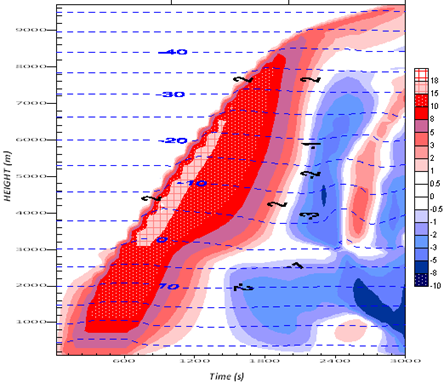 | Figure 1. Time evolution of vertical velocity (m/s) and temperature (°C)- dashed line (case of initial continental aerosol spectrum) |
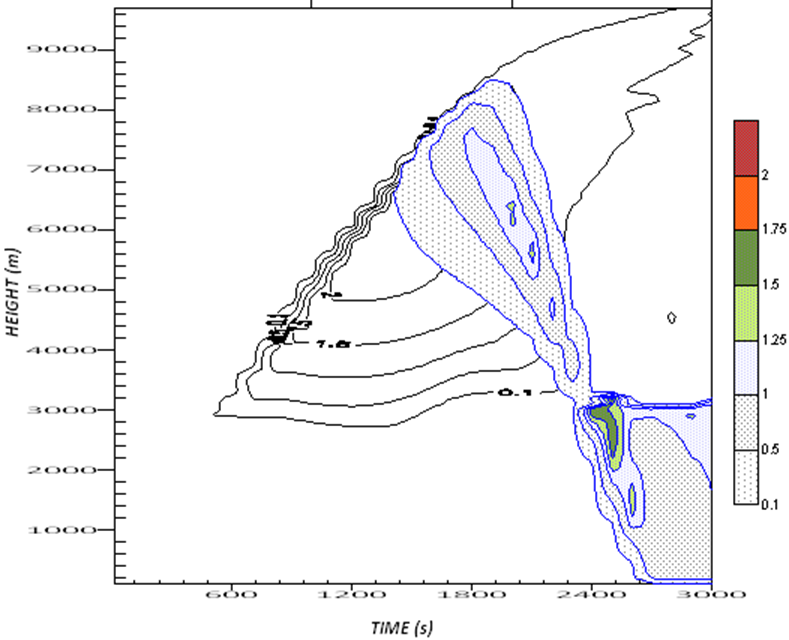 | Figure 2. Evolution of liquid water content in gm-3 as a function of height (meters) and time (s) for initial continental aerosol spectrum. The cloud droplets (r <40μm) are in black and in blue precipitating droplets |
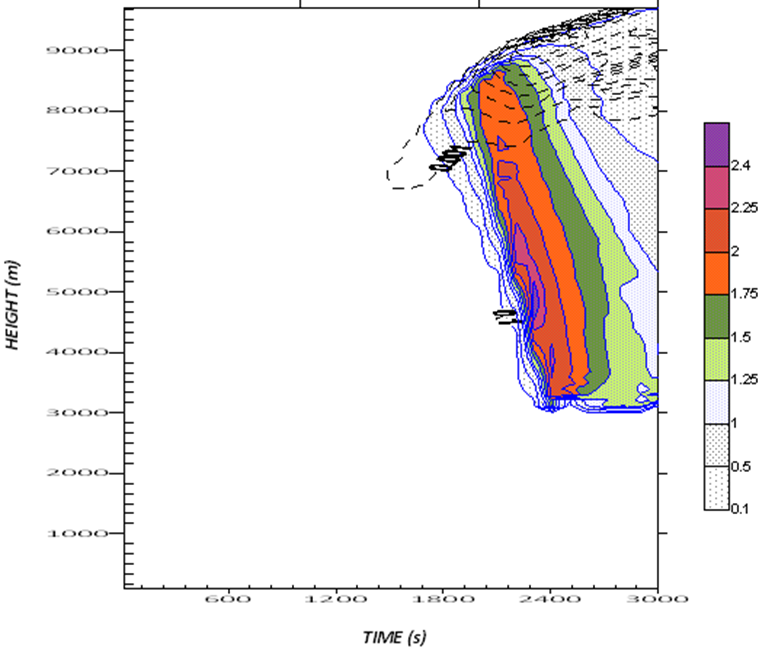 | Figure 3. Evolution of ice content in gm-3 as a function of height (meters) and time (s) for initial continental aerosol spectrum. The ice cloud droplets (r <40μm) are in black and in blue precipitating ice particles |
3.2. Simulation with Marine Aerosol Spectrum
- In the second simulation, the initial continental spectrum of aerosols was replaced by a broad marine aerosol spectrum using the model of Jaenicke[12]. As a result, Figure. 4 shows that the updrafts are more prevalent between 4000 and 8000 meters height with a maximum of 18m/s. The downdrafts in the cloud are shorter but become stronger near the surface beyond 40 minutes of integration. As shown in Figure. 5, precipitating water appears earlier (22 minutes instead of 33 minutes) at lower elevations (5400 instead of 9200 meters). Rainfall reaches the ground more rapidly (37 minutes instead of 48 minutes) and the amount of water collected on the ground is more important with liquid water content up to 2 g/m3 (Figure. 5).
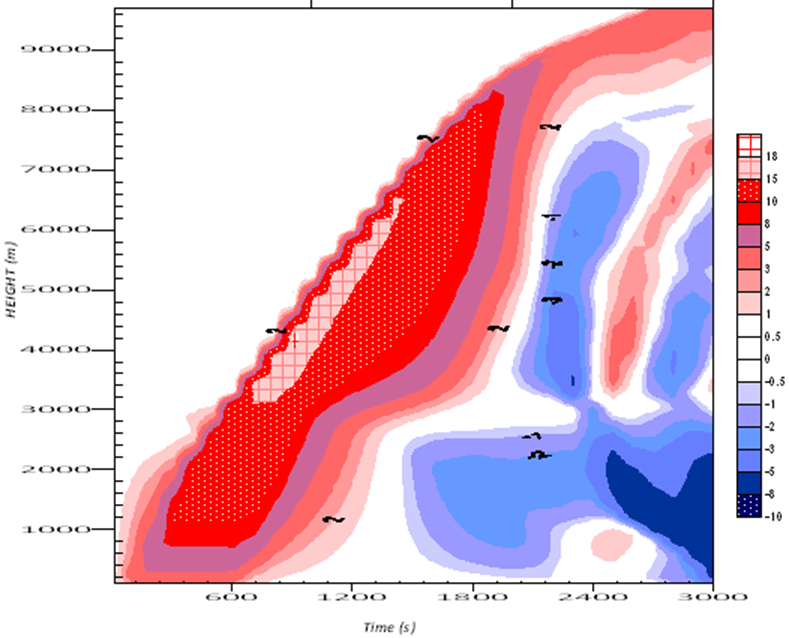 | Figure 4. Time evolution of vertical velocity (m/s) |
3.3. Simulation with MEDEX Predicted Aerosol Spectrum
- The coastal aerosols spectrum predicted by the model MEDEX depends mainly on the strength of the wind at the sea surface and the size of the sea surface under the influence of this wind (fetch). The submicron particles decrease slightly as the wind speed increases while the concentration of giant particles (radii> 2μm) increases with wind speed. As the weather situation in the reference case (day of July 19, 1981) is a purely convective, the horizontal wind speed measured at the surface is relatively weak (<4 m/s).
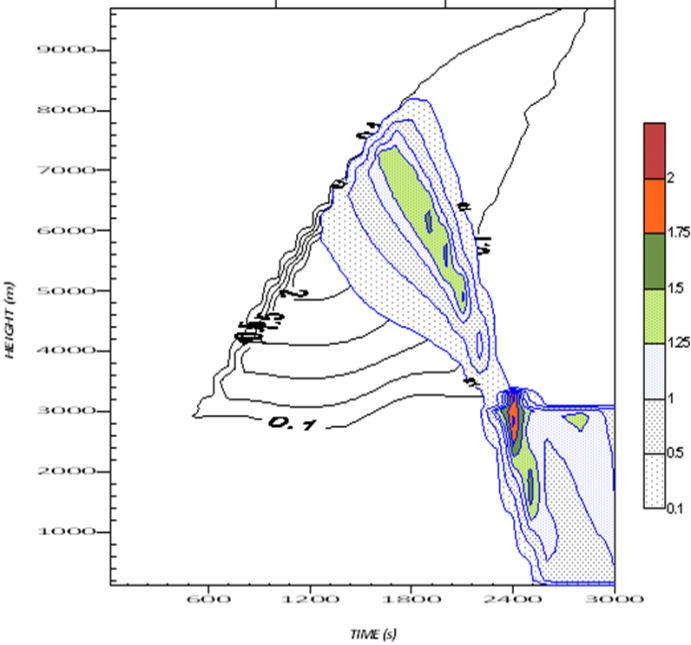 | Figure 5. Evolution of liquid water content in gm-3 as a function of height (meters) and time (s) for initial marine aerosol spectrum. The cloud droplets (r <40μm) are in black and in blue precipitating droplets |
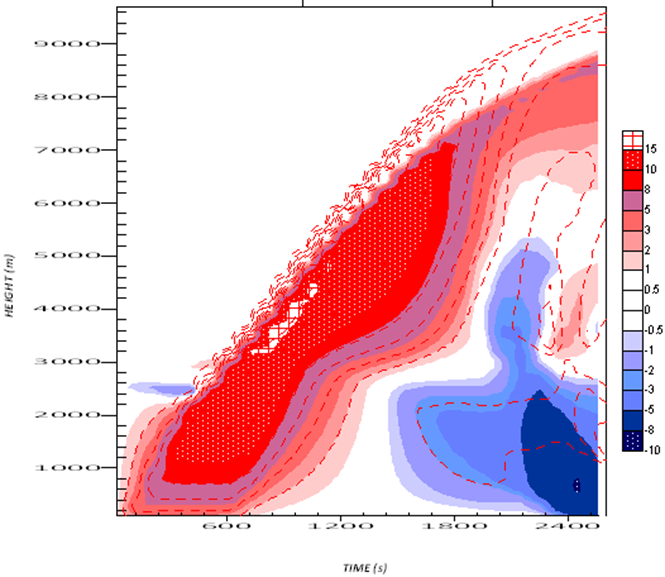 | Figure 6. Time evolution of vertical velocity (m/s) for the simulation with the Medex aerosol spectrum (surface wind speed of 20 m/s and a fetch of 30km). The dashed line corresponds to the results of the Figure 5 (case of marine aerosol spectrum) |
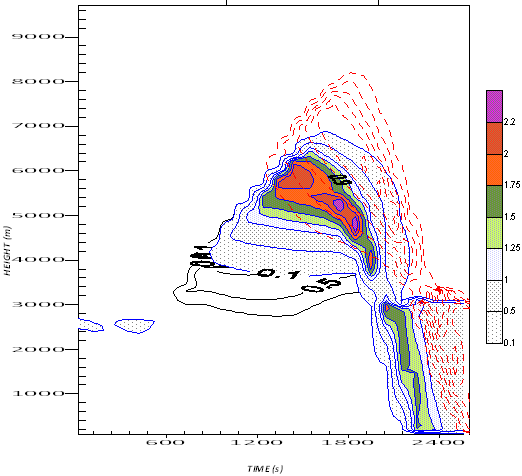 | Figure 7. Evolution of liquid water content in gm-3 as a function of height (meters) and time (s) for initial marine aerosol spectrum (surface wind speed of 20 m/s and a fetch of 30km). The cloud droplets (r <40μm) are in black and in blue precipitating droplets. The dashed line corresponds to the results of the Figure 6 (case of marine aerosol spectrum) |
3.4. Discussion
- In the first simulation, it was noted that the number of cloud particles formed in continental air masses is predominant especially in the growth phase of the cloud (Figure.11). However, the resulted precipitating liquid water content is weaker compared to values obtained for the simulations using marine aerosols and the difference is more evident in presence of coastal marine aerosols (Figure 11). Actually, as already demonstrated[37-38], the number of droplets forming in continental air masses is quite large, but these droplets are relatively small, and hence, they do not fall as precipitation and most of them remain suspended in clouds and continue growing by diffusion.In the same context, the updrafts velocities are stronger in the continental case and cloud droplets reach higher heights than in the maritime cases. The contribution of the ice particles in the rain process is more pronounced in the continental case (Figure.3) since cloud particles reach heights cold enough to produce ice particles and to activate the various growth processes of ice crystals and in particular the secondary ice production detailed by Cardwell et al.[19] and Hallet and Mossop[20]. Compared to the first and second simulations, the precipitating particles are more prevalent at altitudes below 6600m instead of 8400m (Figure. 7) in the case of maritime aerosol spectrum predicted by MEDEX model. Those particles are formed earlier (since 20 minutes of integration) at lower altitudes between 4000m and 6000m (Figure. 11 and Figure. 12) where they reach their peak with a maximum rain water content greater than 3g.m-3 recorded at an altitude of 5000m. Indeed, all liquid and solid particles larger than 40μm falls to reach the ground ten minutes earlier (Figure. 1 and Figure. 11). The produced quantities of water reaching the soil are more intense and more important (Figure. 7 and Figure. 13). Since the first two modes of the spectrum calculated by MEDEX are contaminated by a contribution from continental aerosols, large concentrations of sub-micrometer aerosols are predicted in particular for the nucleation and the accumulation modes (respectively 104 cm-3 and 102 cm-3). The question in this case is to determine to what extent these modes are responsible of the large amounts of precipitation accumulated at the ground. In general, several modelling studies [4],[34] and satellite imagery[8] have highlighted the reduction of precipitation at the ground in case of convective clouds developing in polluted environments. High concentrations of small atmospheric aerosols are known to reduce the size of cloud droplets, increase cloud albedo and suppress precipitation formation. In contrast, cloud simulations suggest that even low concentrations of large soluble aerosols should promote droplets growth and rainfall.
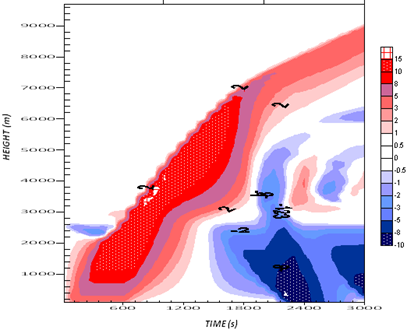 | Figure 8. Time evolution of vertical velocity (m/s) for the simulation with the Medex aerosol spectrum (surface wind speed of 20 m/s and a fetch of 90km) |
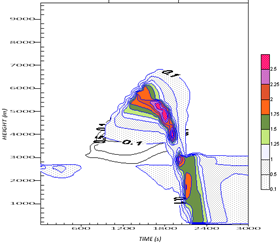 | Figure 9. Evolution of liquid water content in gm-3 as a function of height (meters) and time (s) for the simulation with the Medex aerosol spectrum (surface wind speed of 20 m/s and a fetch of 90km). The cloud droplets (r <40μm) are in black and in blue precipitating droplets |
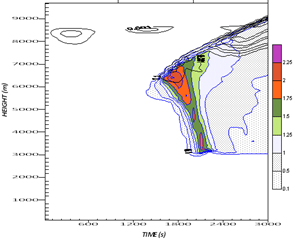 | Figure 10. Evolution of ice content in gm-3 as a function of height (meters) and time (s) for the simulation with the Medex aerosol spectrum (surface wind speed of 20 m/s and a fetch of 90km). The ice cloud droplets (r <40μm) are in black and in blue precipitating ice particles |
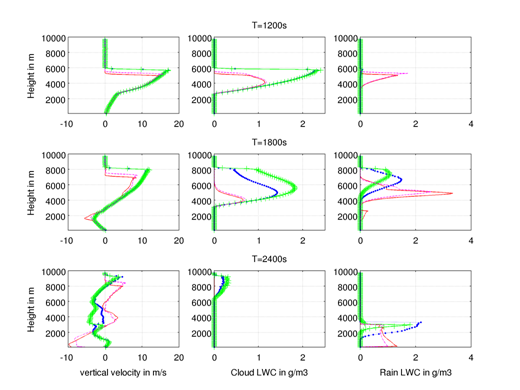 | Figure 11. Vertical profiles of the three parameters: vertical velocity in m/s, liquid water content of cloud droplet in g/m3 and Rain liquid content of precipitating cloud droplets in g/m3 for different phases of the cloud life (time= 1200s, 1800s et 2400s). The red continue line and the magenta dashed line for simulations with Medex aerosol spectrum with surface wind of 20m/s and fetches of respectively 90km and 30km. The blue line corresponds to the marine spectrum and the green line for continental aerosol spectrum |
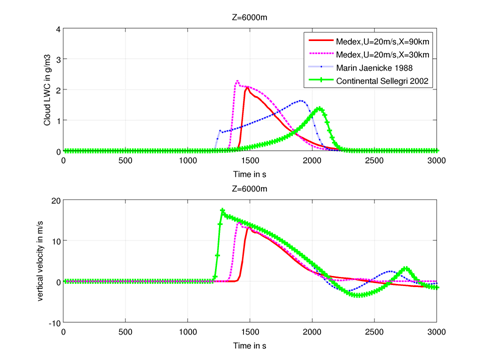 | Figure 12. Evolution of the vertical velocity in m/s and the liquid water content of cloud droplet in g/m3 at the altitude of 6 Km |
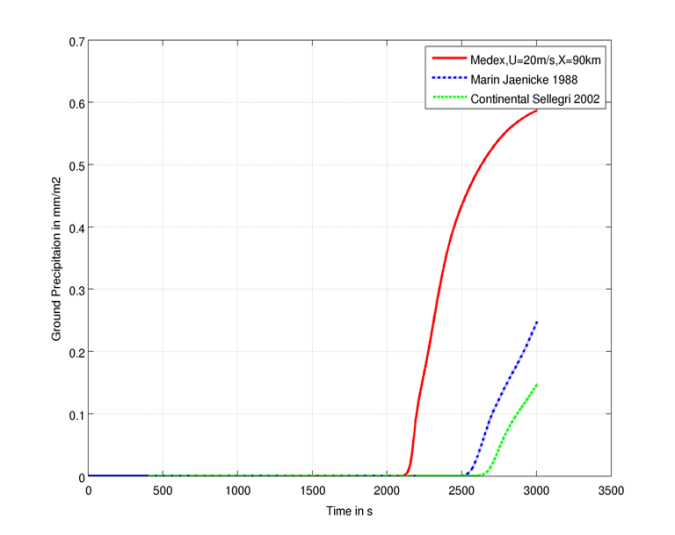 | Figure 13. Evolution of the rain accumulation at the ground (mm/m2) for the different simulations |
4. Conclusions
- In this study, three types of aerosol spectrum of different origins were used. If the continental spectrum is more focused on continental fine particles (r <0.1 μm) with major concentrations around 103 cm-3, the marine spectrum of Jaenicke[12] contains more large particles (between 0.2μm and 2μm) with lower concentrations (about 102 per cm- 3 of air). The coastal marine spectra suggested by Piazzola et al.[13] are characterized by the presence of giant particles (around 10 μm) but with lower concentrations. In this case, the transition from a continental aerosol spectrum to a marine aerosol spectrum is synonymous to the introduction of aerosol particles of large size. The impact of such change in the initial spectrum of aerosol is much felt in terms of dynamic and microphysical responses of the cloud.From the dynamic standpoint, there is a reduction of the spatial-temporal coverage of the maximum of the updrafts and a strengthening of the subsidence especially in the lower levels associated with more intense rainfall. The cloud is then composed, in the higher altitudes, by non-precipitating ice crystals.In a microphysics point of view, there is an early starting of the process of precipitation (10 minutes earlier) and at lower altitudes (2600 meters below). Precipitation reaching the ground is more important and more intense. Those results are in concordance with those commonly founded when comparing results obtained for continental and marine initial aerosol spectra using other kind of cloud models[35-36].Moreover, the simulations also showed a difference in the behavior of the cloud microphysics when taking into account the natural production of coastal marine aerosols through the coupling (MEDEX-EXMIX). The precipitating cloud droplets forms at lower altitudes (less than 6000 m) and are more prevalent in altitudes below 5000m. The liquid water content is larger and the cloud is composed mainly by small ice particles after that precipitating droplets falls. Areas of updrafts were less marked and subsiding flows are stronger in the lower layers. The amount of water reaching the soil is more important and is twice higher than those obtained using an initial marine spectrum (Jaenicke [12]) and four times higher compared to those associated to a continental spectrum. Since the first mode of the MEDEX predicted spectrum is contaminated by coastal aerosols with continental origin and considering that their concentration decreases in the presence of strong winds blowing over a long fetch ([25],[31]), simulations have been performed again for wider fetches (90 km). The results show similar microphysical and dynamic behaviors with an increase in precipitation collected at the ground for increasing lengths of fetch and also for increasing values of the surface wind speed.
ACKNOWLEDGEMENTS
- Our thanks go to the Laboratory LSEET (UMR 6017), University of Toulon for their kind invitation to attend the coastal marine aerosols measurement campaign MIRAMAR and to the Laboratory of Physical Meteorology, University of Blaise Pascal in Clermont Ferrand for their guidance and authorization to use the model EXMIX.
References
| [1] | W. Wobrock, "Numerische Modellsimulationen von strahlungnebelepisoden unter berücksichtigung spektraler wolkenmikrophysik", PhD thesis, Francfort, 1988. |
| [2] | M. Monier, "Développement d’un modèle de cirrus à microphysique détaillée", Thèse de l’université Blaise Pascal, Clermont-Ferrand, 2003. |
| [3] | M. Monier, W. Wobrock, JF Gayet, AI Flossmann, "Development of a detailed microphysics cirrus model tracking aerosol particles histories for interpretation of the recent INCA campaign", Journal of Atmospheric Science, Vol. 63, pp.504-525, 2006. |
| [4] | D. Leroy, M. Monier, W. Wobrock, AI. Flossmann, "A numerical study of the effects of the aerosol particle spectrum on the development of the ice phase and precipitation formation", Journal of Atmospheric Research, Vol.80, pp. 15-45, 2006. |
| [5] | JP. Mulcahy, CD. O’Dowd, SG. Jennings, D. Ceburnis, "Significant enhancement of aerosol optical depth in marine air under high wind conditions". Geophysical Research Letters, Vol.35, pp.L16810, 2008. |
| [6] | P. Masclet, H. Cachier, "L’aérosol atmosphérique: Caractéristiques physico-chimiques". Analusis, Vol. 26, pp.11-16, doi: 10.1051/analusis:199826090011, 1998. |
| [7] | AP. Khain,A. Pokrovsky, I. Sednev, "Effects of cloud-aerosol interaction on cloud microphysics, precipitation formation and size distribution of atmospheric aerosol particles: numerical experiments with a spectral microphysics cloud model", Journal of Atmospheric Research, Vol.52, pp.195-220, 1999. |
| [8] | D. Rosenfeld, "Suppression of rain and snow by urban and industrial air pollution", Science, Vol.287, pp.1793-1796, 2000. |
| [9] | A. Givati, D. Rodenfeld, "Quantifying precipitation suppression due to air pollution", Journal of Applied Meteorology, Vol.43, pp.1038-1056, 2004. |
| [10] | IL. Jirak, WR. Cotton, "Effect of Air Pollution on Precipitation along the Front Range of the Rocky Mountains", J. Appl. Meteor. Climat,Vol. 45, pp.236-246, 2006. |
| [11] | B. Lynn, AP. Khain, D. Rosenfeld, WL. Woodley, "Effects of aerosols on precipitation from orographic clouds", Journal of Geophysical Research, Vol.112, doi:10.1029/2006JD- 007537, 2007. |
| [12] | R. Jaenicke, "Aerosol physics and chemistry. In : Landolt-Boernstein: Zahlenwerte und Funktionen aus Naturwissenschaften und Tecknik", V 4b, G. Fischer, Editor, Springer, pp.391-457, 1988. |
| [13] | J. Piazzola, F. Bouchara, AMJ. Van Eijk, G. De Leeuw, "Development of the Mediterranean extinction code MEDEX", Optical Engineering, Vol.42, pp.912-924, 2003. |
| [14] | T. Asai, A. Kasahara, "A theoretical study of the compensating downward motions associated with cumulus clouds", Jounal of Atmospheric Science, vol.24, pp.487-596, 1967. |
| [15] | HR. Pruppacher, JD. Klett, "Microphysics of Clouds and Precipitation", 2nd ed., Publisher: Kluwer academic publishers, Dordrecht, 1997. |
| [16] | PK. Smolarkiewicz, "A simple positive definite advection scheme with small implicit diffusion", Monthly Weather Review, Vol.111, pp.479-486, 1983. |
| [17] | MP. Meyers, PJ. Demott, WR. Cotton, "New primary ice nucleation parameterizations in an explicit cloud model", Journal of Applied Meteorology, vol. 31, pp.708-721, 1992. |
| [18] | A. Bott, "A positive definite advection scheme obtained by nonlinear renormalization of the advective fluxes", Monthly Weather Review, Vol.117, pp.1006-1015, 1989. |
| [19] | J. Cardwell, PR. Field, TW. Choularton, "A modeling study of ice-spectrum modes in deep frontal clouds", Q. J. R. Meteorol. Soc, Vol. 129, pp.1873–1890, 2003. |
| [20] | J. Hallett, SC. Mossop, "Production of secondary ice crystals during the riming process", Nature, Vol. 249, pp.26-28, 1974. |
| [21] | JE. Dye, JJ. Jones, WP. Winn, TA. Cerni, B. Gardiner, D. Lamb, RL. Pitter, J. Hallet, CPR. Saunders, "Early electrification and precipitation development in a small isolated Montana cumulonimbus". Journal of Geophysical Research, vol.91, pp.1231-1247, 1986. |
| [22] | RJ. Cipriano, EC. Monahan, PA. Bowyer, DKO. Woolf, "Marine condensation nucleus generation inferred from whitecap simulation tank results", Journal of Geophysical Research, Vol.92, pp. 6569-6576, 1987. |
| [23] | EC. Monahan, CW. Fairall, KL. Davidson, PJ. Boyle, "Observed interrelation between 10m winds, ocean whitecaps and Marine aerosols", Quarterly Journal of the Royal Meteorological Society, Vol.109, pp.379-392, 1983, doi: 10.1002/qj.49710946010. |
| [24] | A. Van Eijk, G. De Leeuw, "Modelling aerosol size distribution over the North Sea", Journal of Geophysical Research, Vol.97, pp.14417–14429, 1992. |
| [25] | E. Vignati, G. De Leeuw, M. Schulz, E. Plate, "Characterization of aerosols at a coastal site near Vindeby (Denmark)", Journal of Geophysical Research, Vol.104, pp.3277–3287, 1999. |
| [26] | J. Piazzola, S. Despiau, "Vertical distribution of aerosol particles near the air-sea interface in coastal zone". Journal of Aerosol Science, Vol.28, pp.1579-1599, 1997. |
| [27] | CD. O’Dowd, MH. Smith, SG. Jennings, "Submicron aerosol, radon and soot carbon characteristics over the North East Atlantic", Journal of Geophysical Research, Vol.98, pp.1123 - 1135, 1993, doi: 10.1029/92JD02387. |
| [28] | K. Sellegri, "Etude du processus d’activation des particules d’aérosols: implications en chimie multiphases", Thèse de l’Université Joseph Fourier, Grenoble, 2002. |
| [29] | SG. Gathman, "Optical properties of the marine aerosol as predicted by the Navy aerosol model". Optical Engineering, Vol.22, pp.57-62, 1983. |
| [30] | J. Piazzola, AMJ. Van Eijk, G. De Leeuw, "An extension of the Navy Aerosol Model to coastal areas". Optical Engineering, Vol.39, pp.1620-1631, 2000. |
| [31] | J. Piazzola, G. Kaloshing, "Performance evaluation of the coastal aerosol extinction code MEDEX with data from the Black Sea". Journal of Aerosol Science, Vol.36, pp.341–359, 2005. |
| [32] | H. Gerber, "Relative-humidity parameterization of the Navy aerosol model", Naval Research Laboratory, NRL Report.8956, pp. 13, 1985. |
| [33] | S. Bendersky, N. Kopeika, N. Blaunstein, "Middle East measurements of concentration and size distribution of aerosol particles for coastal zones", Optical Engineering, Vol.44, pp.106003-106013, 2005. |
| [34] | T. Reisin, Z. Levin, S. Tvizion, "Rain production in convective clouds as simulated in an axisymetric model with detailed microphysics, Part II : Effects of varying drops and ice initiation". Journal of Atmospheric Science, Vol.53, pp.1815-1837, 1996. |
| [35] | A. I. Flossmann, "Interaction of aerosol particles and clouds", Journal of Atmospheric Science, Vol.55, pp.879-887, 1998. |
| [36] | D. Leroy, W. Wobrock, A. I. Flossmann, "On the influence of the treatment of aerosol particles in different bin microphysical models: a comparison between two different schemes". Journal of Atmospheric Research, Vol.85, pp.269- 287, 2007. |
| [37] | B. Lynn, A. Khain, D. Rosenfeld, W. L. Woodley, "Effects of aerosols on precipitation from orographic clouds", Journal of Geophysical Research, Vol.112, pp. D10225, 2007. |
| [38] | A. Khain, D. Rosenfeld, A. Pokrovsky, "Aerosol impact on the dynamics and microphysics of convective clouds", Q. J. R. Meteorol. Soc, Vol.131, pp.2639–2663, 2005. |
 Abstract
Abstract Reference
Reference Full-Text PDF
Full-Text PDF Full-text HTML
Full-text HTML